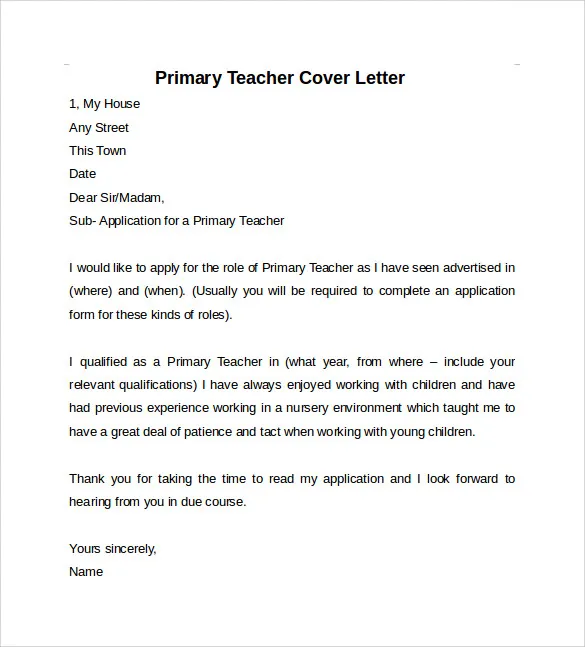What Is a Teacher Cover Letter
A teacher cover letter is a crucial document that accompanies your resume when applying for teaching positions. It serves as a personal introduction, allowing you to highlight your qualifications, skills, and experiences in a more detailed and compelling way than your resume alone. A well-crafted cover letter can significantly increase your chances of landing an interview and ultimately, securing your dream teaching job. This document offers a valuable opportunity to showcase your personality, teaching philosophy, and passion for education, setting you apart from other candidates.
Purpose of a Teacher Cover Letter
The primary purpose of a teacher cover letter is to persuade the hiring committee that you are the best fit for the position. It’s not just a summary of your resume; it’s a chance to tell your story, explaining why you want to teach, what you can bring to the school, and how your skills align with their needs. It allows you to demonstrate your written communication skills, your understanding of the role, and your enthusiasm for the school or district. A strong cover letter shows your personality, highlights your unique qualities, and makes a memorable impression on the reader.
Key Components of a Teacher Cover Letter
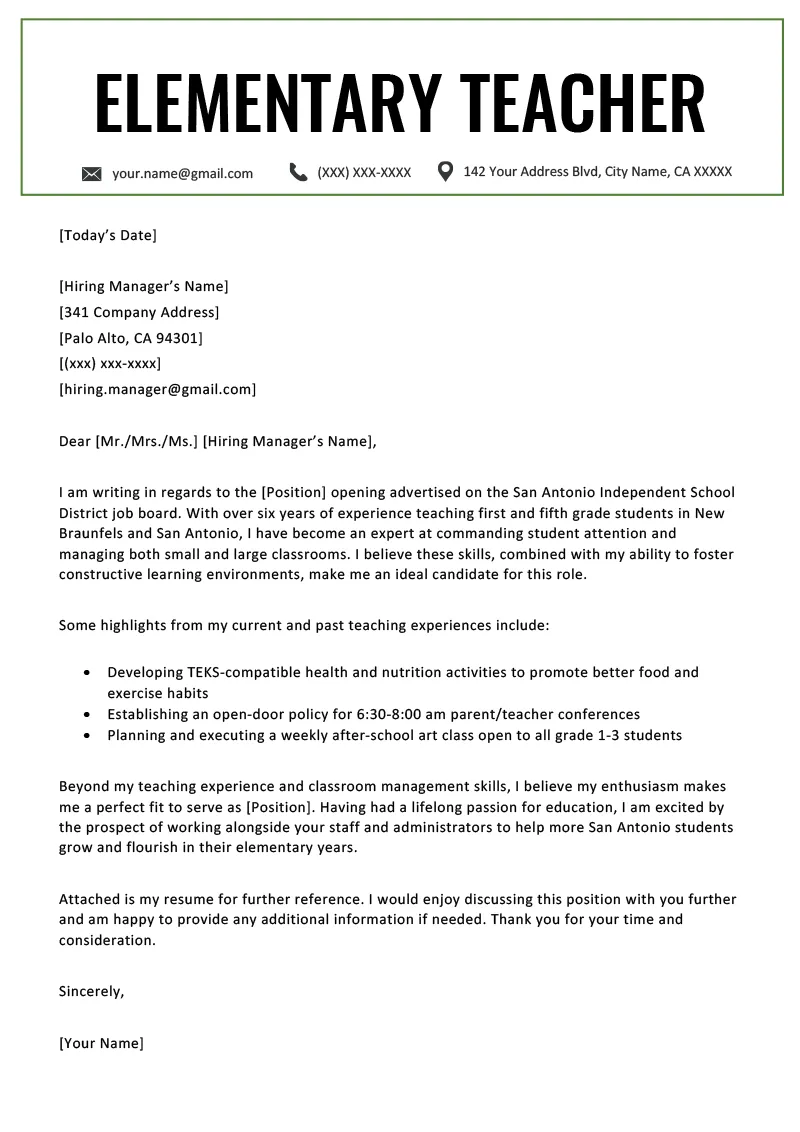
Header and Contact Information
Begin your cover letter with a professional header that includes your full name, address, phone number, and email address. Ensure this information is accurate and up-to-date. You should also include the date and the recipient’s contact information, usually the name of the principal or hiring manager, their title, the school’s name, and the school’s address. Proper formatting and attention to detail in the header set a professional tone and make it easy for the reader to contact you.
Salutation
Use a professional salutation. If you know the hiring manager’s name, address them directly with “Dear Mr./Ms./Mx. [Last Name].” If you are unsure of the name, a more general salutation like “Dear Hiring Committee” or “Dear [School Name] Principal” is acceptable. Avoid generic salutations like “To Whom It May Concern,” as they can make your letter feel impersonal. The salutation sets the tone for the rest of your letter, so make it friendly and professional.
Opening Paragraph Grab Attention
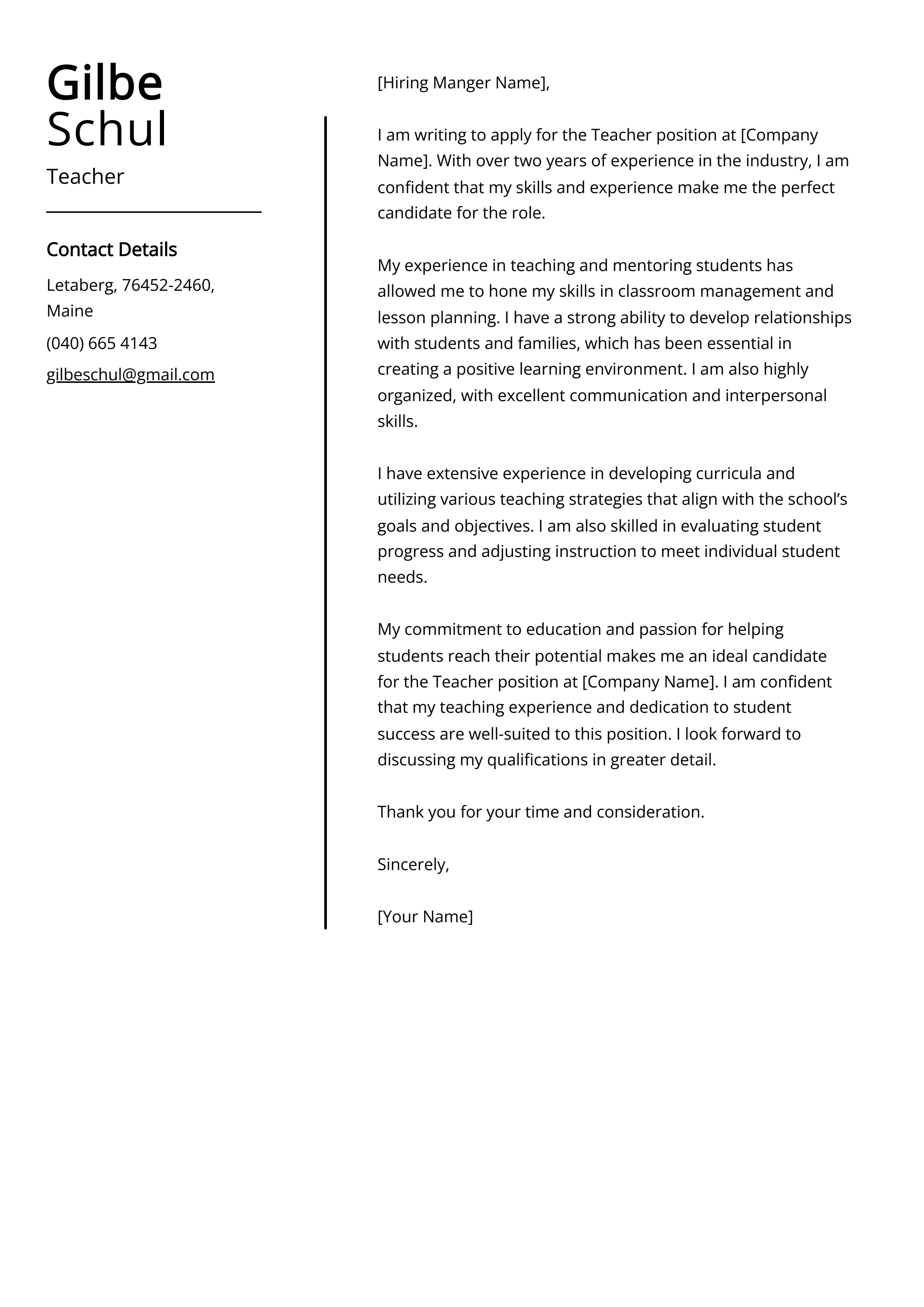
The opening paragraph is your first chance to grab the reader’s attention. Start with a strong statement that expresses your interest in the position and the school. You might mention where you saw the job posting, and briefly state why you are a good fit. Briefly touch upon your most relevant qualifications, or express your enthusiasm for the school’s mission or values. This paragraph sets the stage for the rest of the letter and encourages the reader to continue. Make it concise, engaging, and relevant to the specific job.
Body Paragraphs
The body paragraphs are where you provide details about your qualifications, experiences, and skills. This is the core of your cover letter. Use this space to elaborate on the most relevant aspects of your resume, providing specific examples to support your claims. Tailor the content to the specific requirements of the job, emphasizing how your skills and experiences align with the school’s needs and values. Show, don’t just tell – use anecdotes and concrete examples to demonstrate your abilities and passion for teaching.
Highlighting Qualifications
In this section, highlight your relevant qualifications, such as your teaching certifications, degrees, and any specializations. Mention your teaching experience, including the grade levels and subjects you’ve taught. If you have experience with specific curricula, technology, or teaching methodologies, mention it here. Focus on the qualifications that are most relevant to the job description. Be specific and provide evidence of your skills and abilities, rather than simply listing your qualifications.
Demonstrating Passion and Experience
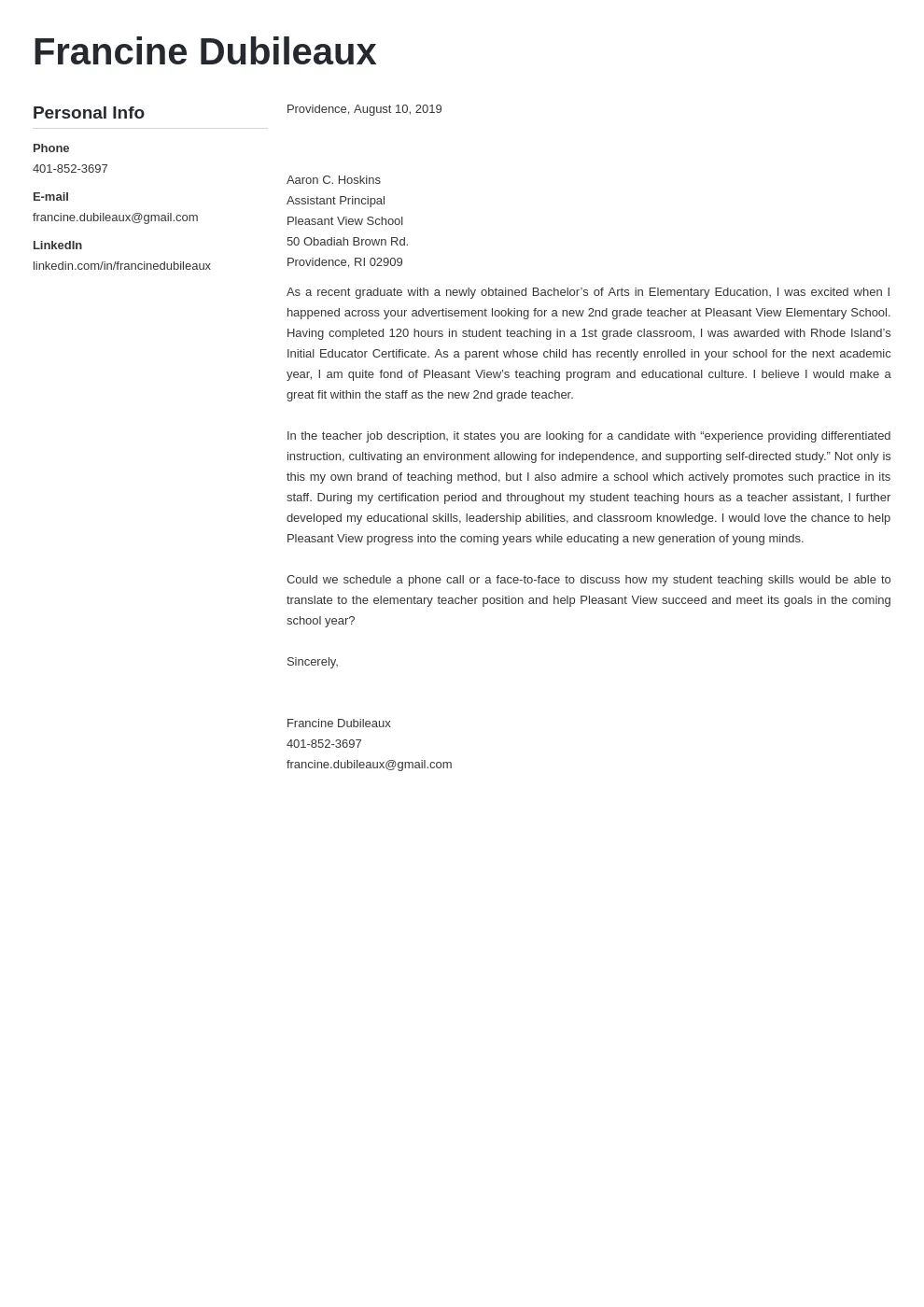
Express your passion for teaching and your commitment to student success. Share examples of your experience, such as successful lesson plans, classroom management techniques, or positive student outcomes. Discuss your teaching philosophy and how it aligns with the school’s mission. Show your enthusiasm for working with students and your dedication to creating a positive and engaging learning environment. Use strong action verbs to describe your achievements and make your experience come alive.
Showcasing Achievements and Skills
Provide specific examples of your achievements and skills, such as improved student test scores, successful implementation of new programs, or positive feedback from parents and colleagues. Quantify your achievements whenever possible (e.g., “increased student engagement by 20%”). Highlight skills that are relevant to the job, such as communication, collaboration, leadership, and technology skills. Make sure to align these skills with the requirements outlined in the job description.
Closing Paragraph
In the closing paragraph, reiterate your interest in the position and express your gratitude for the reader’s time and consideration. Reiterate your enthusiasm for the opportunity. Briefly summarize why you are the ideal candidate. Thank the hiring manager for considering your application. Keep the tone positive and professional. Avoid sounding desperate or overly casual.
Call to Action
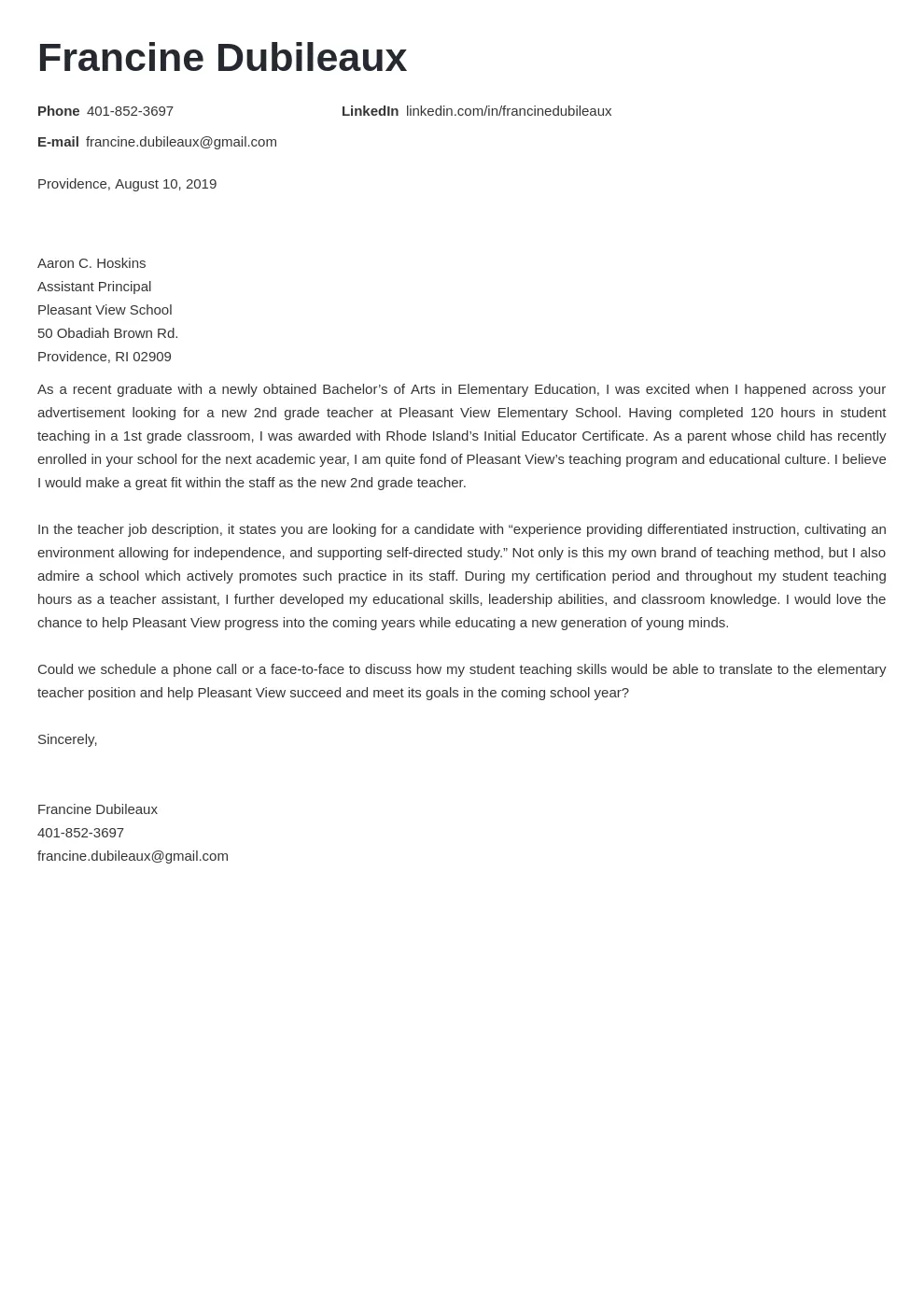
End with a clear call to action. This could be a statement like, “I am eager to discuss my qualifications further in an interview,” or “I look forward to the opportunity to speak with you about how I can contribute to [School Name].” Provide your contact information again. Make it easy for the reader to take the next step. Express your eagerness to hear back from them.
Formatting and Style
Font and Font Size
Choose a professional and easy-to-read font, such as Times New Roman, Arial, or Calibri. Use a font size between 11 and 12 points. The font and size should be consistent throughout the letter. Ensure the font is clear and legible, making it easy for the reader to scan the document. Avoid using unusual fonts that could distract from the content.
Margins and Spacing
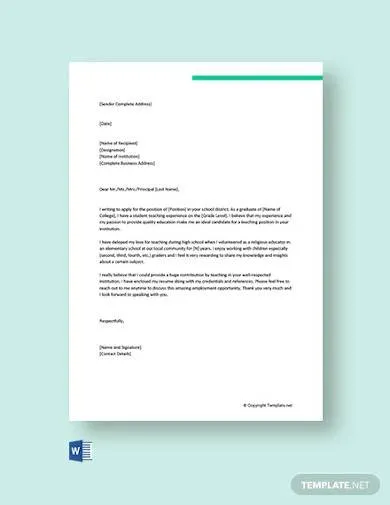
Set margins to one inch on all sides of the document. Use single-spacing for the body of the letter and double-spacing between paragraphs. Proper margins and spacing make the letter visually appealing and easy to read. Adequate spacing prevents the letter from appearing cramped and allows for a more professional presentation. Ensure the letter is well-organized and visually balanced.
Proofreading and Editing
Before submitting your cover letter, carefully proofread and edit it for any errors in grammar, spelling, and punctuation. Errors can create a negative impression and undermine your credibility. Ask a friend or colleague to review your letter as a second pair of eyes can often catch mistakes you may have missed. Ensure your writing is clear, concise, and professional. A polished cover letter shows that you pay attention to detail and are committed to quality.
Tailoring Your Cover Letter
Researching the School or District
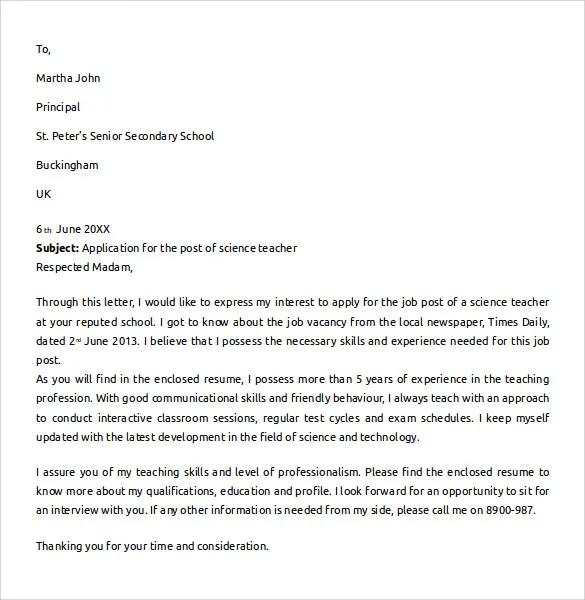
Before writing your cover letter, research the school or district. Visit their website to learn about their mission, values, programs, and initiatives. Understanding their priorities will help you tailor your letter to their specific needs. Show that you have taken the time to understand their organization and are genuinely interested in joining their team. This level of preparation demonstrates your initiative and commitment.
Matching Your Skills to Job Requirements
Carefully read the job description and identify the key skills and qualifications the school is seeking. Align your cover letter with these requirements by highlighting relevant experiences and skills. Use the same keywords and phrases used in the job description where appropriate. Show how your qualifications match their needs. This targeted approach demonstrates that you understand the role and are a good fit for the position.
Using Keywords
Incorporate relevant keywords from the job description throughout your cover letter. This will help your application get noticed by applicant tracking systems (ATS) and hiring managers. Use keywords naturally and strategically, rather than stuffing them into your text. Keywords can be related to your skills, teaching methodologies, or the school’s values. Using relevant keywords can significantly increase the visibility of your application and demonstrate your understanding of the role.
